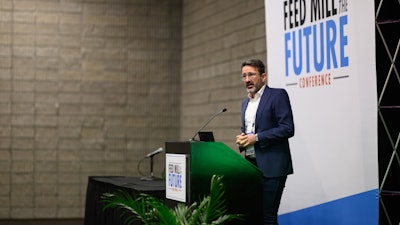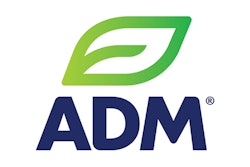
Insects provide an opportunity to tackle dual challenges for the future food system: increased protein demand and organic waste management. Insects enable the recycling of nutrients from organic waste and reintegrate them into local feed and food value chains.
Thierry Duvanel, director of innovation, Bühler Group, drew on Bühler’s experience as the process solution provider for French insect producer Agronutris to offer an overview of this innovative strategy at Feed Mill of the Future Conference on January 30 during the International Production & Processing Expo (IPPE).
Duvanel admitted that while the idea of introducing insects as a protein source may provoke negative reactions, he aimed to convince the audience of insect protein’s merit as a sustainable animal feed supplement and eventually for human consumption.
“We know that by 2050, we will have around 10 billion people,” Duvanel said. “The population is growing and one thing that we need to feed – to nourish – this population in a sustainable and balanced way is proteins. On the other hand, we have a food system that permanently, consistently wastes about a third of what is being produced.”
The current food system relies on 25% of primary proteins for human consumption, with 60% used for animal feed and 15% lost or wasted, Duvanel said.
This poses challenges for agriculture because the planet’s arable land is almost entirely used, meaning the proteins used for animal feed are becoming less reliable in terms of volume and costs.
Insects: the circular protein source
The circular economy is the framework behind utilizing insects for feed purposes. Insects such as black soldier flies (BSF) and mealworms can be used as a protein source for feed applications, as they convert waste into food while the remaining byproduct, known as frass, serves as fertilizer within the agriculture sector.
“Insects eat waste — they live on the waste we generate from different foods,” Duvanel said. “If we’re able to set up an industry where we use these losses to feed insects, they can be used for protein content as feed. Then we have a new economy taking place and this is already starting to happen.”
The burgeoning industry centers on three specific species, with the black soldier fly taking the lead. BSF’s profile checks all the necessary boxes for sustainability, Duvanel said, because it thrives on wet feedstock, has a relatively short reproduction cycle and substantial protein content.
While BSF has emerged as the preferred choice for most feed applications, mealworms offer another worthy option. Mealworms require slightly longer reproduction cycles and live on dry feedstock, which Duvanel said can be an advantage, depending on the application and the environment. They’re used primarily for feed, but also can have food applications.
Once the industry is built up, Duvanel said we can begin to consider using insect protein resources for direct food applications, pointing to crickets as the leading contender. He noted that crickets have been consumed for centuries in different parts of the world. They have much longer production cycles than BSF and mealworms, but account for a lower environmental footprint than animal protein production.
Industrial-scale insect farming
The insect-based feed production industry requires specialized equipment, such as larvae rearing facilities and processing plants. When examining the overview of the technologies involved, Duvanel delineated two primary streams. One focuses on organic residues, encompassing waste collection and preparation. This requires a series of steps tailored to the specific waste material or residue to effectively prepare the feedstock for the insects.
The second stream involves the insect cultivation cycle, beginning with genetic selection and progressing through life stages from eggs to neonate larvae and, ultimately, adult flies.
Within the insect rearing and larvae processing stream, there are two substreams — one is dedicated to food applications, involving the extraction of protein meal and lipids for the formulation of animal nutrition products; the other substream is residue processing. This represents a valuable opportunity for utilizing insect waste as fertilizer to enhance plant nutrition in the industry.
Duvanel said for these processes to take place on an industrial scale requires massive specialized, fully automated facilities. But the need today is for more pilot plants and research and development plants, which are typically around 50 square meters.
“The focus here is not production, but to test the production lobby and validate the mass balance,” Duvanel said. “The smallest plants we see that are profitable on an industrial scale are in the range of 10,000 to 20,000 square meters. That represents typical output between 3 and 10 tons a day, a traditional size for complete industrial plants.”
Insect market landscape
Estimated global production stands between 80 and 220 kilotons, indicating significant growth potential as production scales up and costs decrease.
Projections suggest the future dominance of insect-derived feed, with global production reaching an anticipated 700 kilotons annually by 2030, according to Duvanel. He forecast that, by then, the leading applications will be in pet food, aquafeed and other diversified sectors.
The shift toward insect-based feed can be seen globally. While Europe has spearheaded developments thus far, Duvanel said there is considerable potential in North America, with an expected investment of $250 million to $300 million in the next three to five years, representing 20% to 25% of worldwide investment.
Duvanel said collaborations and partnerships between European companies and major players in the United States, like Cargill and ADM, underscore the promising growth of the global insect industry.
Within the market, certain sectors are poised to capitalize on the unique attributes of insect-derived proteins.
“Pet food is an example of the first market to pick up because of the premium nature of the products, but also thanks to the hypoallergenic status of insect protein,” Duvanel said. “This application is going to be a dominator.”
Aquafeed also presents significant growth potential, Duvanel said.
“In the long term, this is going to be an Asian market mainly dominated by the applications in aqua and the availability of kitchen waste as a feedstock,” Duvanel said.


















